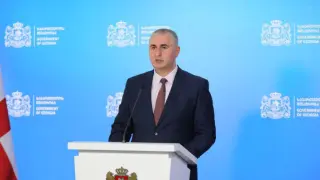Lasha Khutsishvili: “Funding for social programmes in the 2026 budget increases by GEL 540 million.”
Verdict: FactCheck concludes that Lasha Khutsishvili’s statement is TRUE.
Funding for the Ministry of Internally Displaced Persons from the Occupied Territories, Health, Labour and Social Affairs will increase by GEL 800 million, reaching GEL 9.6 billion, according to the draft state budget for 2026. Direct spending on social programmes will rise by GEL 638 million to GEL 7 billion. This includes a GEL 517 million increase for pensions, bringing the total to GEL 5 billion and a GEL 83 million rise for social assistance, pushing it to GEL 1.7 billion.
Pensions for people under 70 will increase by GEL 20 to GEL 370 whilst pensions for those aged 70 and above will grow by GEL 45 to GEL 495. Annual growth in the number of pensioners also contributes to the rising pension bill.
Social assistance recipients who gain employment can keep their benefits for four years under the revised approach. This change, alongside a higher minimum eligibility score and increased child benefits, has significantly expanded the number of beneficiaries and the programme’s budget in recent years.
Social payments for pensions with disabilities and those with severe disabilities will also rise by GEL 20 and GEL 45, starting in 2026. As age-based pensions increase, the automatic 20% pension supplement paid to residents of high-mountain regions will grow as well.
Total spending on social programmes will be GEL 638 million higher in 2026 than in 2025 according to the budget draft. Considering the above, FactCheck concludes that Lasha Khutsishvili’s statement is TRUE.
Analysis
Whilst speaking about the 2026 state budget on TV Imedi’s programme Imedis Kvira, Lasha Khutsishvili stated: “The budget for social programmes will increase by roughly GEL 540 million which will go toward pension provision and various forms of social assistance.”
Funding for the Ministry of Internally Displaced Persons from the Occupied Territories, Health, Labour and Social Affairs will increase by GEL 800 million, reaching GEL 9.6 billion according to the second revised version of the 2026 state budget – which is essentially identical to the first.
This is the largest ministry, covering multiple sectors and sub-sectors. More than half of its funding – GEL 5 billion – is allocated to pensions.
The old age pension will rise by 5.7% for people under 70 – from GEL 350 to GEL 370. For those aged 70 and older, the pension will increase by 10% – from GEL 450 to GEL 495.
Pension adjustments are regulated by the Law of Georgia on Pensions. Pensions under this law for individuals under 70 must increase by at least the average inflation rate over the past 12 months but not by less than GEL 20. For individuals aged 70 and above, pensions must rise by the sum of the average inflation rate over the past 12 months and 80% of the average real GDP growth over the past six quarters.
In addition to the nominal pension itself, the number of pensioners is also increasing. There were 663,000 old age-pension recipients in December 2012 whereas by December 2019, the figure had reached 763,000 and by October 2025 it stood at 885,000. As a result, the annual pension spending is rising faster than the pension amounts alone. The share of pension expenditures within total budget spending is also growing. More will be spent on pensions alone than on the defence and education ministries combined in 2026.
Table 1: Budget of the Ministry of Internally Displaced Persons from the Occupied Territories, Health, Labour and Social Affairs of Georgia (GEL Million)
Source: Ministry of Finance of Georgia
Funding for social assistance targeted at vulnerable groups will also rise by GEL 83 million, reaching GEL 1.7 billion. Social assistance recipients constituted 708,000 people as of October with 462,000 receiving only the cash benefit whilst 246,000 were enrolled in the state employment programme. Their beneficiary status is guaranteed for four years. Both the number of beneficiaries and the programme’s budget have increased sharply, driven by several factors:
- The minimum eligibility score was raised from 100,000 to 120,000.
- Employed recipients can now retain the assistance for four years instead of losing it immediately.
- Child benefits for those under 16 were increased to GEL 200 per month.
Around GEL 855 million is spent annually on social assistance, accounting for roughly half of the total budget for targeted social programmes, based on October 2025 data. The remaining funds go toward disability benefits, pension supplements for residents of high-mountain regions and other social programmes. As of October 2025, 86,000 pensioners received the 20% pension supplement, costing GEL 7 million. This supplement rises automatically when the base pension, to which it is tied, increases. Additionally, social payments (pensions) for persons with disabilities will increase by GEL 20 and by GEL 45 for persons with severe disabilities starting in 2026.
Old age-based pensions, social assistance, disability benefits and pension supplements for high-mountain regions are all consolidated under a single budget line (27 02) for social protection, which will rise by GEL 638 million to reach GEL 7 billion, according to the draft. Furthermore, funding for universal health insurance – which also carries a social function – will increase by GEL 130 million.
Whilst the GEL 638 million figure is nearly GEL 100 million higher than the GEL 540 million cited by Lasha Khutsishvili, this discrepancy does not change the overall assessment. Considering the above, FactCheck concludes that Lasha Khutsishvili’s statement is TRUE.








